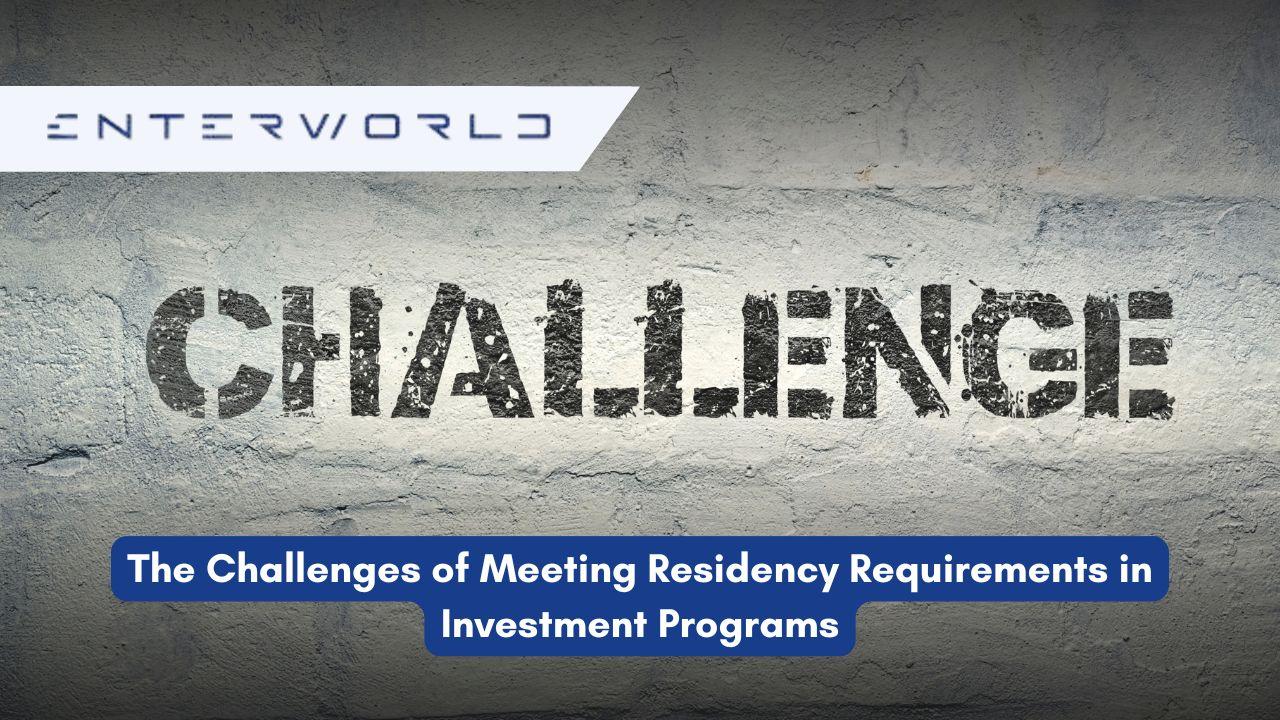Investment programs, such as those offering residency through economic contributions, have become increasingly popular as individuals seek to diversify their lifestyles, reduce tax burdens, and gain access to better opportunities for their families. Many of these programs, including Golden Visa programs, offer the promise of residency (and eventually citizenship) in exchange for substantial investments in a country’s economy.
However, despite the significant financial incentives, meeting the residency requirements for these programs can be challenging. The demands can be time-consuming, require careful documentation, and may impose personal or financial constraints that complicate the investment process.
In this article, we’ll explore the challenges faced by investors when meeting the residency requirements of investment programs and provide guidance on how to navigate these hurdles.
1. Understanding Residency Requirements in Investment Programs
Residency through investment programs usually involves several key components, including:
- Physical Presence Requirements: Investors must spend a certain number of days in the host country over a period of years to maintain their residency status.
- Minimum Investment Thresholds: Many programs require substantial financial commitments, such as buying real estate, donating to a national fund, or investing in local businesses.
- Ongoing Financial Obligations: Some programs require that investors maintain their investment for a set number of years, often with minimal liquidation of assets.
Meeting the residency requirements means that individuals must balance these commitments with their personal and professional obligations. Here’s a closer look at the most common challenges investors face in these programs.
2. Time Commitment and Physical Presence
One of the most significant challenges investors face when participating in residency by investment programs is the time commitment involved. Many countries require applicants to spend a set number of days per year (often ranging from 30 to 183 days annually) within the country to qualify for residency or citizenship.
-
Challenge 1: Travel and Logistics
Maintaining physical presence can be difficult for investors with businesses, families, or other commitments outside the host country. If an investor has multiple business interests in different parts of the world or a family to care for, spending the required amount of time in the host country can be logistically complicated. -
Challenge 2: Scheduling Conflicts
Investors may need to rearrange business or personal schedules to comply with the program’s residency requirements. For individuals who travel frequently for work or who live in multiple locations, meeting the physical presence requirement might not always be feasible. -
Challenge 3: Financial and Personal Impact
Being away from home or business for extended periods can also affect income generation, business operations, or family life. This can make the decision to participate in investment programs more complicated from both a financial and emotional standpoint.
3. Restrictions on Continuous Residency
Some investment programs are stricter than others when it comes to continuous residency. Many programs require investors to establish permanent residence and live in the country for an extended period before being eligible to apply for citizenship.
-
Challenge 4: Absences May Reset the Clock
In certain countries, if an investor is absent from the country for more than a certain period of time (e.g., six months), they may lose their residency status or have to start the residency period over again. This can disrupt plans for long-term residency or citizenship. -
Challenge 5: Maintaining Residency Without Citizenship
In some cases, investors may hold residency for many years but not yet be eligible for citizenship. This leaves them in a state of uncertainty, not knowing if their residency will eventually lead to full citizenship. If they face difficulties maintaining their residency, such as being unable to meet the physical presence requirement, they risk losing all the benefits of the investment.
4. Financial Burdens and Maintaining the Investment
Investment programs typically require significant financial contributions, whether through real estate purchases, government donations, or business investments. Maintaining these investments to satisfy residency requirements over the long term can present significant financial challenges.
-
Challenge 6: Long-Term Financial Commitment
In some cases, investments must be maintained for several years before the investor is eligible for citizenship. Investors may find it difficult to liquidate their investments before the required time period, which can tie up substantial amounts of capital. This long-term financial commitment can create challenges for individuals who may want to use those funds for other purposes or who experience changes in their financial situation. -
Challenge 7: Market Risks and Economic Changes
Investments in real estate or businesses are subject to market risks. Economic downturns, changes in property values, or business performance can negatively affect the value of the investment, potentially complicating the investor’s ability to fulfill the residency requirements. Moreover, shifts in government policy or changes to residency laws can affect the status of the investment.
5. Documenting Compliance with Residency Requirements
Maintaining accurate documentation and proof of physical presence in the host country can be cumbersome. Investors must keep detailed records of their time spent in the country and provide evidence of their residency in the form of:
-
Travel documents (e.g., passports, flight records)
-
Residency certificates or local tax records
-
Utility bills, rental contracts, or other proof of address
-
Challenge 8: Complex Documentation Processes
The documentation process can be complicated, especially if the investor has moved frequently or spent time in multiple locations. Ensuring that all records are properly compiled, translated (if necessary), and submitted on time is essential to avoid complications when proving residency. -
Challenge 9: Bureaucratic Delays
Some countries may have slow or inefficient bureaucratic processes, which can make it difficult for investors to receive official residency certificates, renewals, or other necessary documents in a timely manner. These delays can impact the investor’s ability to meet the residency requirements and can result in additional stress.
6. Changing Immigration Policies
Immigration policies and laws surrounding residency and citizenship are subject to change. Governments may amend their investment residency programs, either tightening or relaxing requirements, based on political priorities or economic conditions.
-
Challenge 10: Policy Shifts
Political instability, changes in government, or shifts in public opinion about investment immigration can lead to abrupt changes in the requirements of investment programs. In some cases, governments may introduce new taxes, penalties, or regulations that make it more difficult to meet residency requirements or maintain an investment. -
Challenge 11: Unexpected Program Suspensions
Some countries have been known to temporarily suspend their investment programs due to changes in their political climate or international pressure. This can leave investors stranded if they have already committed funds or moved to the country.
7. Solutions to Overcome These Challenges
While meeting the residency requirements of investment programs can be difficult, there are steps investors can take to navigate the challenges:
- Plan Ahead: Carefully research the residency and physical presence requirements of the program you are considering, and create a timeline that allows you to fulfill these obligations without affecting other areas of your life.
- Consult Professionals: Work with immigration lawyers or consultants who are familiar with investment residency programs and can help you navigate the bureaucratic processes, including documentation and compliance.
- Diversify Investments: Consider spreading your investments across different assets or jurisdictions to reduce risks and allow more flexibility if your circumstances change.
Conclusion
While investment programs offer a pathway to residency and citizenship, they come with a unique set of challenges that applicants must consider. From time commitments and financial burdens to documentation and changing regulations, meeting residency requirements in these programs can be complex. By understanding these challenges and preparing in advance, investors can successfully navigate the process and maximize the benefits of their investment.
Before committing to an investment program, it’s essential to weigh the residency requirements and ensure they align with your lifestyle, business needs, and long-term goals. With careful planning and professional advice, you can overcome these challenges and make the most of your investment in a new country.



